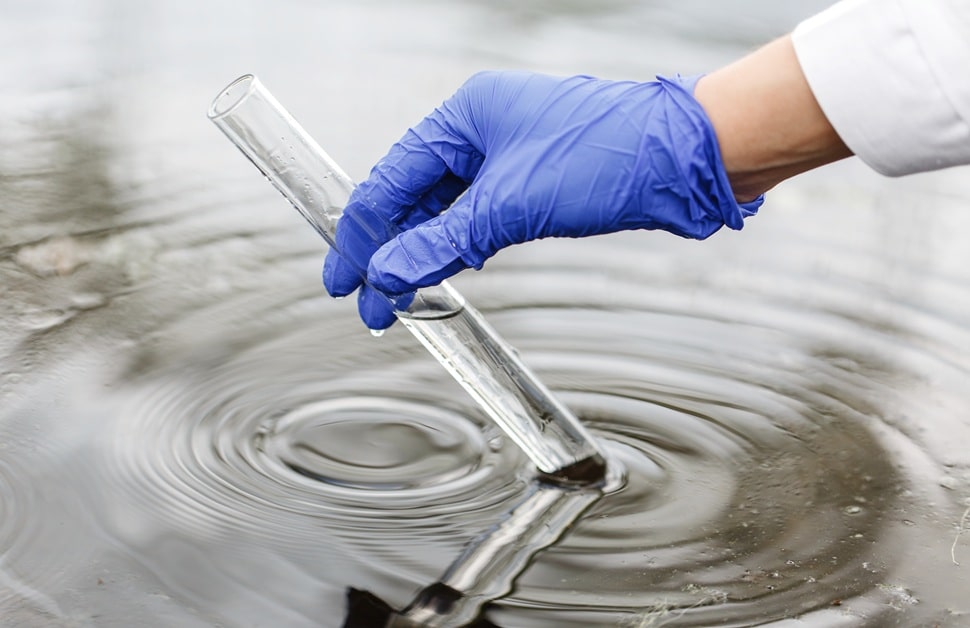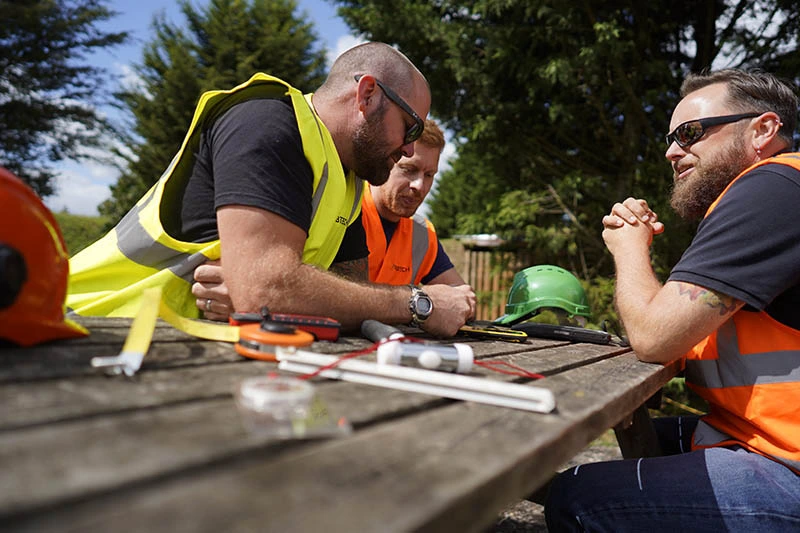
Evaluate Contaminated Land Issues with Rapid Survey Reports
A contaminated land survey is a risk assessment of soil, groundwater, and other environmental conditions on a specific site to identify potential risks posed by harmful substances.
Contaminated land surveys play a critical role in protecting public health, the environment, and ensuring compliance with planning regulations.
What is Contaminated Land?
Contaminated land refers to any area where the soil, groundwater, or air has been polluted by potentially hazardous substances, making it potentially unsafe for human habitation, agriculture or environmental health.
Such contamination can occur due to past or present industrial activities, improper waste disposal, chemical spills, or naturally occurring substances that exceed safe levels.
Causes of Contaminated Land
- Industrial and Commercial Activities: manufacturing, mining, and fuel storage can introduce pollutants such as heavy metals, petroleum hydrocarbons and solvents.
- Waste Disposal: poorly managed landfill sites, illegal dumping, and historical waste disposal practices can cause ground contamination.
- Agricultural Practices: the excessive use of pesticides, herbicides, and fertilisers can lead to pollution of soil and controlled waters.
- Accidental Spills and Leaks: leaks from underground storage tanks, pipeline ruptures, or transport accidents can introduce hazardous chemicals into the immediate environment.
- Natural Sources: some areas naturally contain high levels of harmful elements like arsenic or radon.
Risks from Contaminated Land
Contaminated land can pose several risks to public health, the environment, and property values. Some of the key threats include:
- Health risks: exposure to toxic substances such as heavy metals, asbestos, hydrocarbons, and volatile organic compounds can lead to respiratory problems, cancers, and other serious health issues.
- Environmental harm: contaminants can seep into the ground, causing soil and groundwater contamination, potentially causing significant harm to local wildlife and ecosystems.
- Structural integrity issues: some contaminants can corrode building materials, affecting the stability of structures.
- Legal and financial liabilities: landowners and developers may face legal action and financial penalties if contamination issues are not addressed properly. Contaminated land can also lower property values.

Insight into Land Contamination Surveys
What is a Contaminated Land Survey?
A contaminated land survey (also known as a contaminated land risk assessment) is a structured process used to determine the potential hazards and risks associated with land that may be polluted with harmful substances.
This assessment is vital for developers, landowners, relevant planning authorities and regulatory bodies to ensure that land is safe for future users and that any risks to human health and the wider environment are appropriately managed.
A contaminated land survey will clarify any potential contamination issues on an individual site and should provide the relevant local authority with all the information it requires when it considers an application for planning consent.
Why are Contaminated Land Surveys Needed in the UK?
These surveys are particularly relevant in the UK due to the country’s industrial history; its legacy is that many brownfield sites are potentially polluted. Factories, landfills, mines, and industrial plants often left harmful chemicals in the soil or groundwater. Over time, these substances can pose risks to people, property, and the wider environment.
The National Planning Policy Framework (NPPF) underscores the importance of addressing land contamination when developing or redeveloping sites. Developers must ensure that their projects do not increase pollution or risk to health. Additionally, the Environmental Protection Act 1990 introduced the “polluter pays” principle, making those responsible for contamination liable for clean-up costs. However, when the original polluter cannot be identified, the responsibility may fall on the current landowner or developer.
For these reasons, contaminated land investigations are often required to support planning applications, especially for areas with a history of industrial activity. These surveys help identify and mitigate risks on potentially contaminated land or controlled waters, ensuring that development projects are safe for future uses.

When is a Contaminated Land Survey Needed?
There are several scenarios that require a contaminated land survey:
- Prior to land development: if a developer wants to build on contaminated land, or previously developed brownfield sites, obtaining planning consent requires demonstrating that any risks from contamination will be appropriately managed. A contaminated land survey will ensure a site is safe for its proposed use and enable a developer to discharge planning conditions.
- Change of land use: if land use is changing (e.g., from industrial to residential), potential contamination must be assessed to ensure safety.
- Regulatory requirements: authorities may require a contaminated land assessment to comply with environmental regulations and for regulatory records.
- Property transactions: buyers and investors may require a contaminated land survey to identify potential hazards before purchasing land.
- Industrial sites and waste management areas: sites with a history of industrial use or waste disposal need land contamination surveys to prevent pollution from spreading.
Contaminated Land Survey Process
Land contamination surveys follow a structured approach:
Phase 1 Desk Study – Preliminary Risk Assessment
Involving a review of historical land use to assess the likelihood of contamination from the site history. A conceptual site model may be created outlining potential sources, pathways, and receptors of contamination.
Phase 2 – Site Investigation
During an intrusive site investigation, environmental consultants will collect and analyse soil, water, and gas samples for laboratory analysis. The extent and type of contamination will be assessed during the site walkover survey to evaluate potential risks to human health and the wider environment.
Phase 3 – Risk Assessment and Remediation Strategy
If contamination is found, a risk assessment will be developed based on findings. Remediation measures might involve removing contaminated soil, capping affected areas, or treatment solutions. Reports will be submitted to the relevant authorities for regulatory approval.
Phase 4 – Implementation and Validation
Remediation solutions will be implemented. Post-remediation testing will be carried out, followed by further testing to confirm that remediation has successfully mitigated the risks. Final approval from environmental authorities will be obtained.

The Contaminated Land Survey Report
A comprehensive contaminated land report will include:
- A Summary of Findings: A clear explanation of the contamination identified, its sources, and its extent.
- A Risk Assessment: An evaluation of the risks to human health, property, and the environment.
- Recommendations: Detailed proposals for managing or remediating the contamination.
- A Compliance Statement: Confirmation that the report meets all relevant regulations and planning conditions.
How a Contaminated Land Survey Report Will Satisfy Planning Conditions
Local planning authorities require contaminated land surveys to ensure that new development projects are safe and do not exacerbate existing contamination.
What does a contaminated land survey look for?
Land contamination surveys demonstrate compliance with planning policies by:
- Identifying Contamination Risks: Clearly outlining the nature and extent of contamination on the site.
- Assessing Impacts: Providing a thorough evaluation of potential risks to people, buildings, and the wider environment.
- Recommending Mitigation Measures: Contaminated land survey consultants will suggest practical steps to remediate or manage contamination, such as soil removal, capping, or groundwater treatment.
- Demonstrating Compliance: Showing that the proposed development will not increase pollution or health risks, in line with the NPPF, Environment Agency guidelines and local planning policies.

Steps to Take if a Land Contamination Survey is Required
- Consult local planning requirements: If the survey is required to support an application for planning permission, check the local authority’s specific requirements. They may outline the level of assessment needed and any guidance documents to follow.
- Engage an environmental consultant: Hiring a qualified environmental consultant to conduct the survey is crucial. Look for a contaminated land survey company that employs consultants with relevant certifications, experience in contaminated land assessments and familiarity with local authority procedures.
- Conduct a Phase 1 Preliminary Risk Assessment: This initial stage involves a desk study and site walkover to gather information about the site’s history and identify potential contamination risks. The consultant will review historical maps, environmental records, and past land uses to develop a Conceptual Site Model (CSM).
- Perform a Generic Quantitative Risk Assessment GQRA (site investigation) if needed. If the Phase 1 assessment identifies potential contamination, a more detailed investigation will follow. This intrusive site investigation involves testing of soil, water, and sometimes air to confirm the presence of contaminants and evaluate their extent and impact.
- Prepare a contaminated land report: The findings from the contaminated land investigation are compiled into a detailed report. This document will be submitted to the local authority as part of an application for planning permission.
Contaminated Land Survey Consultants
A contaminated land assessment must be conducted by qualified professionals with expertise in environmental science, geology, or engineering. These professionals often work for specialist environmental consultancies and must be competent in conducting site investigations, risk analysis, and remediation planning according to the Environment Agency Land Contamination Risk Management guidelines.
Key professionals involved include:
- Geo-environmental consultants: experts who analyse contamination risks and propose mitigation strategies.
- Geo-technical engineers: specialists in soil and ground conditions who assess structural risks related to contamination.
- Regulatory authorities: local planning authorities and environmental agencies oversee and approve assessments in line with National Planning Policy Framework guidelines and the Environment Agency.

How an Environmental Consultant Investigates Potentially Contaminated Sites
Their work typically includes:
- Research and Data Collection: Reviewing historical records, previous environmental assessments, and site-specific information.
- Site Walkovers: Inspecting the site to check ground conditions and identify visual signs of contamination, such as unusual soil conditions or chemical odours.
- Soil and Water Sampling: Using drilling rigs or other equipment to collect samples for laboratory analysis. This helps determine the type and concentration of contaminants present.
- Ground Gas Monitoring: Periodic visits to site to carry out monitoring of borehole installations, using specialist detectors to analyse ground gases like methane, carbon monoxide, oxygen, hydrogen sulphide and carbon monoxide.
- Risk Assessment: Analysing the data to assess risks to human health, property, and the environment. This often involves creating or updating the CSM.
- Mitigation Recommendations: Proposing measures to manage or remediate contamination if necessary.
Contaminated land survey cost
A phase 1 survey can cost approximately £950. Costs for further surveys vary according to site requirements; a phase 2 intrusive survey can start at around £1800.
Take Early Action: Get a Land Contamination Survey Near Me
Assessing and remediating land contamination is crucial for safe redevelopment and protection of the environment and people’s health. Identifying polluted land contamination early ensures that land can be safely developed for future users while complying with environmental regulations and planning policy.
Whether you are a developer considering a planning application, a property owner, or an investor, understanding the risks and engaging highly recommended qualified professionals can help navigate the complexities of contaminated land management effectively. Arbtech’s specialist contaminated land survey consultants are experienced in contaminated land assessment work and can offer professional advice. For further information, fill in the quick contact form at the top of this page.


